
The Castle of Lagos is a medieval castle located in the municipality of Lagos, Portugal. Its walls surrounded the entire city of Lagos, providing the town its main means of defence.

The Castle of Lagos is a medieval castle located in the municipality of Lagos, Portugal. Its walls surrounded the entire city of Lagos, providing the town its main means of defence.
Due to its strategic location, this stretch of coastline has been successively occupied since prehistoric times. In antiquity, the region was visited by Greek navigators, Phoenicians and Carthaginians. When the Romans arrived in the Iberian Peninsula, the primitive village had the Latinized name of Lacóbriga (also written Laccobriga). The new settlement received a quadrangular wall for its defence. The town of Lagos was occupied by Visigoths and later on, in the eight century, by Muslim Moors from North Africa, who renamed the town as 'Zawiya'.
Abd-ar-Rahman III, Caliph of Cordoba, conquered the town in 929 and provided it with towers. The size of these works reflected the economic and strategic importance the town enjoyed, which had a privileged access to Muslim Silves.
During the Christian reconquest of the Iberian peninsula, Lagos was surrendered to King Sancho I in 1189 after the fall of Silves. Almohad Caliph Abu Yusuf Yaqub al-Mansur reconquered the place in 1191, only to be retaken in 1241 by Paio Peres Correia.
From this time there is little reliable information regarding the town's defences under Muslim rule. King Afonso III (1248–1279) began works on the city's walls, which were continued by King Denis (1279–1325) and his successor Afonso IV (1325–1357).
From 1361 onwards, the town of Lagos was separated from the jurisdiction of Silves, reaching administrative independence.
In the context of the Portuguese discoveries, Lagos played an important role. Nearby Sagres was one of the support bases for the conquest of North Africa and the operations of Henry the Navigator (1394–1460), in the first phases of the Age of Discoveries. Due to its harbour, as well as facilities where Caravels and other vessels were built, Lagos played a crucial role in the rise of the Portuguese Empire.
From Lagos left:
With the reign of King John II (1481–1495), the Company of Guinea was moved from Lagos to new premises in Lisbon (1481–1482). King John II and his successor also carried out conservation work on the defenses of Lagos, who endowed it with an aqueduct for the water supply, built somewhere between 1490 and 1521. King Manuel I (1495–1521) granted a second Foral Charter in 1504, reformed a decade later, giving start to the construction of the Governors's Palace.
Under the expansionist project of King Sebastian (1568–1578), Lagos became a city in 1573, becoming the capital of the Kingdom of the Algarve and the residence of the Captains General and Governors. His successor, Cardinal Henry (1578–1580), confirmed the title in 1579.
During the Iberian Union, the strength of Lagos's defences increased. The city managed to fiercely oppose the landing of Francis Drake's forces in 1587, forcing Drake to seek a more vulnerable point in that stretch of coast (eventually attacking Sagres). The damage applied by the English artillery to Lagos, as well as the fear of new attacks on the coast, led to the reconstruction and modernization of its defenses in the following years.

At the time of the restoration of Portuguese independence, conservation works were undertaken on the walls (1642), when the proposal to build a large, pentagonal plant with five bastions at the corners, in the south of the city (1643) was approved.
Later, the city and its defences would be severely affected by the tsunami that devastated the Algarve coast as a result of the earthquake of 1755. The resulting destruction was such that the civilian and military governments were transferred to Tavira, less affected by the natural disaster. At the end of the century, the city center was transferred from the old Praça de Armas (current Praça Infante D. Henrique) to the Cano Square (now Gil Eanes Square).
In the 19th century, the city experienced a surge of economic growth, especially in the fish industry. [1]
The walls and ramparts are classified as national monuments by a decree published on June 20, 1924. [2]
From the second half of the 1950s, the government, through the Directorate General for National Buildings and Monuments, in view of the celebrations of Centenarians, conducted a wide intervention in the built-up heritage of Lagos, rebuilding addorsed buildings to ancient walls and bulwarks, rebuilding the Palace of the Governors, sections of walls and constructed the Discovery Avenue (Avenida dos Descobrimentos), a landfilled increased protection area between the city and the sea. [3]
In 2001, the Baluarte of Porta Vila, was reclassified as an astronomical observatory. [4]
All of the city's defences have an incomplete plant in an irregular pentagon shape.
The medieval structure surrounded the town that developed around the Church of Santa Maria do Castelo.
The new fence, adapted to firearm artillery, is made up of three flank bastions (from Santa Maria, Alcaria and São Francisco) and four towers (the Praça de Armas, the Conception, Porta Room and Santo Amaro).

Dom Henrique of Portugal, Duke of Viseu, better known as Prince Henry the Navigator, was a central figure in the early days of the Portuguese Empire and in the 15th-century European maritime discoveries and maritime expansion. Through his administrative direction, he is regarded as the main initiator of what would be known as the Age of Discovery. Henry was the fourth child of King John I of Portugal, who founded the House of Aviz.

The Algarve is the southernmost NUTS II region of continental Portugal. It has an area of 4,997 km2 (1,929 sq mi) with 467,495 permanent inhabitants and incorporates 16 municipalities.

Lagos is a city and municipality at the mouth of Bensafrim River and along the Atlantic Ocean, in the Barlavento region of the Algarve, in southern Portugal. The population of the municipality in 2011 was 31,049, in an area of 212.99 km2. The city of Lagos proper has a population of approximately 22,000. Typically, these numbers increase during the summer months, with the influx of visiting tourists and seasonal residents. While the majority of the population lives along the coast and works in tourism and services, the inland region is sparsely inhabited, with the majority of the people working in agriculture and forestry.

Gil Eanes was a 15th-century Portuguese navigator and explorer.

The Kingdom of the Algarve, after 1471, Kingdom of the Algarves, was a nominal kingdom within the Kingdom of Portugal, located in the southernmost region of continental Portugal, until the end of the monarchy in 1910.
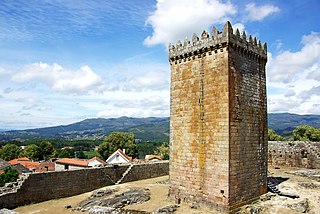
The Castle of Melgaço is located in Vila parish, Melgaço municipality, Viana do Castelo district, in Portugal.

The School of Sagres, also called Court of Sagres is supposed to have been a group of figures associated with fifteenth century Portuguese navigation, gathered by prince Henry of Portugal in Sagres near Cape St. Vincent, the southwestern end of the Iberian Peninsula, in the Algarve.

The Castle of Vinhais is a medieval castle located in the civil parish of Vinhais, municipality of Vinhais, Portuguese district of Bragança.
The Castle Hill of Miranda, also known as the Fortress Hill,, is a medieval castle located in the village of Outeiro in the district of Bragança, Portugal.
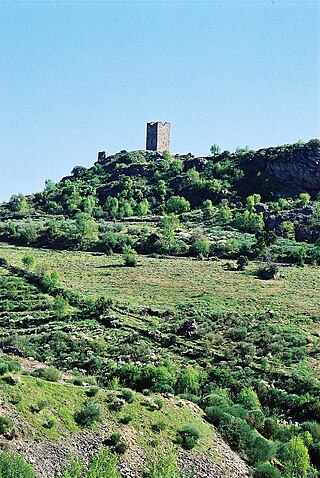
The Castle of Penas Roias is a Portuguese medieval castle in the civil parish of Penas Roias, municipality of Mogadouro, in the Portuguese of district of Bragança.

The Castle of Bragança is a well-preserved medieval castle located in the historic center of the city of Bragança, district of Bragança, Portugal.
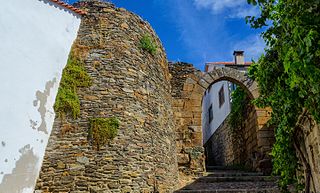
The Castle of Vila Flor is a medieval castle located in the civil parish of Vila Flor e Nabo, municipality of Vila Flor, Portuguese district of Bragança.

The Castle of Serpa is a medieval castle located in the civil parish of Serpa, in the municipality of Serpa, Portuguese district of Beja.

The Castle of Tavira is a medieval castle located in the parish of Santiago, Tavira municipality, Faro district of Portugal. In a dominant position over the mouth of the river Gilão, the settlement has developed as an important sea port since antiquity, with its predecessors dating back to the 8th century BC, passing through the hands of Phoenicians, Greeks, Celts, Carthaginians, Romans, Moors and the Portuguese crown.
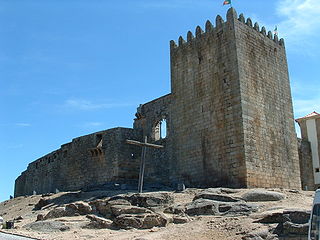
The Castle of Belmonte is a medieval castle located in the municipality of Belmonte, Castelo Branco district in Portugal.

The Castle of Borba is a medieval castle located in the civil parish of Borba, municipality of Borba, Portuguese district of Evora.
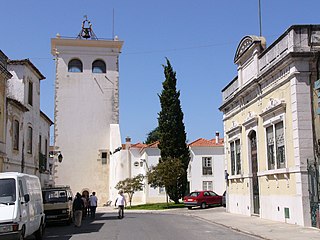
The Castle of Santarém is a medieval castle located in the city of Santarém in the Portuguese county and district of Santarém.

The Castle of Monforte, also referred to as Castelo de Monforte de Rio Livre, is a medieval castle located in the Águas Frias parish, Monforte de village, Chaves municipality in Vila Real district of Portugal.

Fort São Vicente is a military monument in Sagres, in the Algarve region of Portugal. It consists of the remains of a fortification, with a lighthouse inside. It was built in the 16th century to protect a coastal strip and an existing monastery on the site. In 1587 it was destroyed by British privateer Francis Drake, and rebuilt in 1606. In the mid-19th century, a lighthouse was built on the site, which was replaced by a new one in the early 20th century. In the mid-2000s, Cape São Vicente was closed to the public for construction work.

Lagos is a city in the District of Faro, in Portugal. According to tradition, the city was founded about 2,000 years before the Birth of Christ, having been under rule by the Carthaginians, Romans and Muslims. After the Christian reconquest, it played a leading role in the Portuguese Discoveries, becoming the main city in the Algarve, a position it lost to Faro after the devastating earthquake of 1755. Recovery was hampered by the French invasions and the Portuguese Civil War, only regaining some importance in the mid-19th century, with the development of industries, mainly canning. After World War II, a phase of replacement of industrial activities by tourism is witnessed, whose economic importance marks the transition to the Third Millennium.